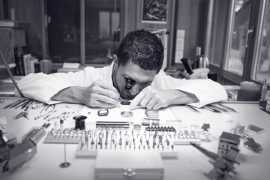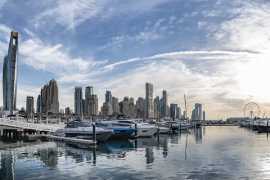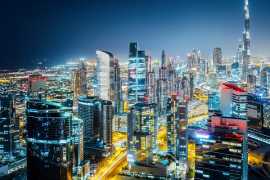Uzbekistan Government presents economic strategy for 2015
By admin Thursday, 12 February 2015 11:56 AM

The Cabinet of Ministers of the Republic of Uzbekistan convened for an extended meeting on January 16 to discuss the outcomes of socio-economic development in the country in 2014 and the crucial priorities of economic program for the year 2015.
President of the Republic of Uzbekistan Islam Karimov delivered a keynote speech at the session. He noted in particular that despite the negative impact of the ongoing global financial and economic crisis, slowdown in the growth rates of world economy and aggravation of processes of stagnation and recession in many countries around the planet, steadily high rates of economic development have been achieved in Uzbekistan owing to the well-directed and systemic implementation of important priorities of the economic program for 2014.
The gross domestic product of the country in 2014 grew by 8.1 percent, production of industrial goods increased by 8.3%, while that of agricultural products swelled by 6.9 percent. Volumes of capital construction grew by 10.9% and that of retail turnover enlarged by 14.3 percent. Ready goods with higher added value accounted for around 70 percent of manufacturing.
The inflation rate was at 6.1 percent, considerably low in comparison with forecast parameters. The national budget was fulfilled with surplus at 0.2 percent of the GDP, with tax burden lowering from 20.5 to 20.0 percent of the GDP and the income tax rate reduced from 9 to 8 percent.
The transformation and consolidation of the banking system created essential prerequisites for the reduction of Central Bank refinancing rate in 2014 from 12 to 10 percent and the corresponding decrease in the interest rate in the loans of commercial banks. Within the last years, leading international rating agencies have been evaluating the activities of Uzbekistan’s banking system as “stable”.
As a result of the implementation of the well-thought-out active investment policy for the wide-ranging modernization, technical and technological upgrading of production capacities, social, transportation and communications infrastructure, the volume of investments into the economy increased by 10.9 percent and reached 14.6 billion U.S. dollars in the equivalent. In this respect, more than 21.2 percent of all capital investments accounted for foreign investments and loans, three fourths of which were direct foreign investments. In excess of 73% of all investments were assigned for production construction. Outfitted with cutting-edge high-tech equipment, 154 major facilities totaling 4.2 billion dollars were commissioned in leading sectors of the economy.
Realization of measures was continued to support and stimulate the domestic exporter manufacturers, to boost the competitiveness of their goods and explore new markets. As a result, the external trade balance closed with surplus at 180 million U.S. dollars, while the gold-currency reserves increased by 1.6 billion dollars.
Systemic measures have been put into action to improve the business environment and create even more favorable conditions for the development of small business and private entrepreneurship, including the introduction of the principle of “one window” in setting up business, maximum simplification of the mechanism of providing statistical and tax reports by small business entities, considerable expansion of access to raw resources for private entrepreneurs. As a result, the share of small business in the GDP grew from 31% in the year 2000 to 56 percent, and from 12.9% to 31.1 percent in industrial production.
The share of services in the GDP enlarged from 53 to 54 percent. Among the high-tech services, the most intensively advancing have been communications and information services, which grew 3.3 times within the last five years, and by 24.5 percent in the previous year.
Dynamic and well-balanced advancement of economy has instituted a robust ground for a steadfast elevation of the living standards of population. The wage of public sector employees, retired pensions and student stipends grew by 23.2 percent last year. Real per capita incomes increased by 10.2%. Some 1 million jobs were created in 2014, 60 percent of which accounted for rural areas, while more than 600 thousand graduates of education institutions were employed.
In his report, President Islam Karimov offered a detailed and comprehensive analysis of the existing unaddressed problems and expounded on the policy tasks directed at executing the most critical priorities and dimensions of socio-economic development of the country for 2015. The government, ministries, other agencies, economic associations and hokimiyats of all levels got tasked with the adoption of necessary measures dedicated to further maintain the high economic growth rates, enhance the structural reforms in the economy, modernize and actively diversify the leading sectors of the manufacturing industry, enhance the production localization, promote transportation and engineering-communication infrastructure. Organizational measures were identified to further reduce the government presence in the economy down to strategically and economically reasonable scopes, to cardinally transform the principles and approaches in the system of corporate governance, remove all the barriers and restrictions, provide for total freedom on the way of development of private property and entrepreneurship, and create an environment conducive for securing the employment of population as well as growth in living standards.
Special significance was attached to ensuring the realization of policy measures to further the goals and tasks for this year determined in connection with its announcement as the Year of Attention and Care for the Senior Generation, including measures to provide for worthwhile attention and comprehensive support for the elderly people, first of all, the veterans of the war and labor front of 1941-1945, uplift the standards and quality of their medical and social services rendered for them, provide the needy with auxiliary and technical means of rehabilitation, bolster the system of organization of work and leisure for the older generation of people.
Heads of Cabinet of Ministers complexes, ministries, other government agencies, organizations and regional hokims spoke to address the issues on the agenda. The discussions at the government meeting produced decision that included practical measures to secure the realization of crucial priorities in the economic program of the country for the year 2015.




























Add new comment